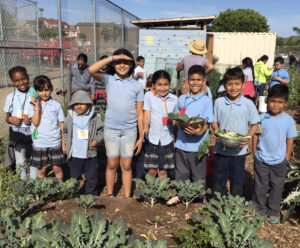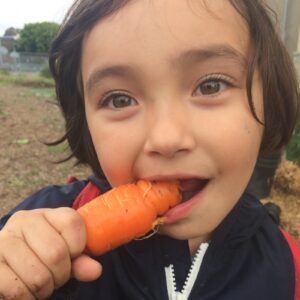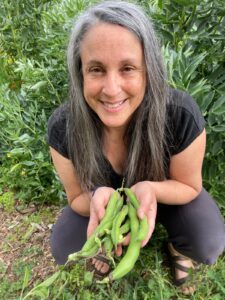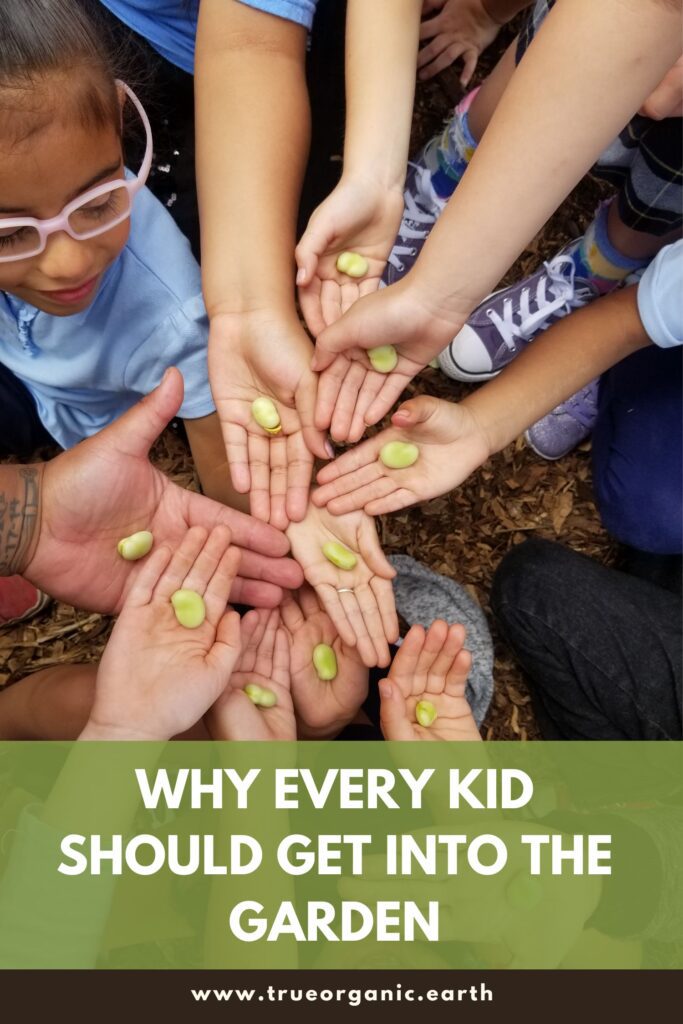August 30, 2022
How Gardening Benefits Kids: Barrio Botany
What makes gardening with kids so special? Ask Christina Abuelo, and the answer is clear. “There’s something magical for kids about being in the garden,” she says.

Volunteer Christina Abuelo is the founder and full-time manager of Barrio Botany, an initiative that builds gardens and garden-based education programs at high-poverty urban schools in San Diego.
“Usually, when a kid is disruptive in class, they’re taken to the principal for discipline. Now we see principals bringing kids out to their school garden to get regulated.”
True Organic is honored to be a donation sponsor of Barrio Botany! We’re so inspired by Christina’s work and wanted to share the story of this life-changing enterprise. So we sat down with Christina to get her take on gardening with kids — why it’s so impactful, how she made it happen, and what she’s seen over the years.
 Building The Garden
Building The Garden
When she moved to San Diego, Christina was searching for a bilingual program for her oldest child to attend. She discovered that she had missed the deadline for enrollment at most schools.
“The only bilingual school I could get my son into was in a very high-poverty neighborhood. But I met with the principal and he sold me on the educational program, so I signed up my kids to go to this school.”
When her son was in first grade, she asked if she could put a garden in the school’s yard.
“I didn’t have a very developed idea of what that would be like,” she laughs, recalling how complex building a garden at an urban school was — without funding or outside support.
Christina started with two garden beds in a litter-strewn part of campus. “The full build-out took 10 years,” she recalls. “My husband would come in on the weekends and assemble raised beds and we had tons of sweat equity from parents and students.” They added about two beds per year. Twelve years later, the School Garden is made up of 14 raised beds, three composting stations, a tool shed, a produce sink, and pollinator habitats.
One year, the urban agriculture class for a nearby high school lost their community garden space, so six more raised beds were delivered by crane, joining the motley collection of existing planting areas.
Over the last three years, Christina has worked to upgrade and install gardens at seven more schools, with assistance from nonprofit partners and community volunteers. Educators from three garden education organizations now provide garden-based education classes and after-school programs.
Although the challenges have been immense, Christina radiates joy when speaking about Barrio Botany.
Her advice for people inspired to build school gardens? Be ready for anything. And be patient. It’s worth it.
“This is my superpower! I can get kids to eat vegetables!”

“As a mom, watching kids eat a plate of cooked kale, I thought, ‘This is my superpower! I can get kids to eat vegetables!’”
She thinks the empowerment aspect helps bring down the barriers between kids and fresh veggies and fruit.
“There’s something about being the one in charge,” she says. “Harvesting something and cooking vegetables themselves makes the kids more excited about trying new flavors.”
She recalls how excited the kids get about eating vegetables when their voices and preferences are respected — like during a “taste test” activity in which the students got to dip their garden-grown veggies (cucumber, carrots, and lettuce) in hummus and rate their favorite tastes.
“It’s about voice and choice. Being able to express what they like is really important.”
Gardens help kids become environmental stewards while learning academic skills.
“Kids really respond to the garden on multiple levels: connecting with nature is a big one.”
Christina sees the kids learning to protect nature because they are developing an appreciation for plants, insects, and wild animals.
“Connecting with nature — finding a roly-poly, seeing the Monarch butterflies at the butterfly bush — seeing all these creatures helps them understand nature and ecosystems. When they grow up, hopefully they’ll be good environmental stewards.”
At the elementary school, the students learn horticultural skills like soil testing, plant identification, weeding, mulching, composting, vermiculture, and cultivation, plus art and cooking/tasting activities.
Students of the garden also learn math skills like calculating volume and square footage — which any gardener knows is involved in all the tasks of building, nourishing, and maintaining a garden!
“There are so many ways gardening-based education can support academic learning,” says Christina. She emphasizes that kids learn better when things are hands-on and experiential.
It’s proven: Studies show that students involved with school gardens generally take pleasure in learning and show positive attitudes towards education (Canaris, 1995; Dirks & Orvis, 2005).
“If you’re only learning about a concept like square footage on a piece of paper, it’s so much harder to conceptualize,” she says. “That physical act — using the measuring tape, recording data on a clipboard, and calculating the square footage — really helps the lessons click and stick.”
She simply asked her children’s principal, “Who’s studying square footage right now?” Turned out: Fourth Graders! So she asked the fourth-grade teacher if they’d like to be learning with the garden, and the class got to measuring and calculating.
“Garden education is so much easier for teaching a lot of academic concepts because the garden brings these concepts to life,” Christina says.
Gardening builds joy and resilience – in kids and grown-ups.
Beyond academic learning, the students gain more important life skills in the garden, like social-emotional learning.
A 2005 study of third, fourth and fifth graders showed that students who participated in a garden program showed increased self-understanding, interpersonal skills, and cooperative skills when compared to their non-gardening peers (Robinson & Zajicek, 2005).
It’s not bad for the emotional health of the teachers and other grown-ups, either. “I’m working 50 or 60 hours a week, but it’s hitting all the dopamine receptors in my brain. I love it.”
And remember: Christina Abuelo is a full-time volunteer!
She can’t emphasize enough how beneficial the garden is for the mental and emotional health of the kids. While she’s been working with school kids in gardens for over a decade, the impact of having a school garden was especially evident as students returned to school after COVID-19 closures.
“These kids were particularly affected by COVID; all the stressors were much more potent for them.”
Students at the schools Christina works with are affected by numerous challenges like food insecurity, poverty, homelessness, unsafe or crowded living environments, limited (or no) access to the outdoors, and other challenges — and so both kids and teachers needed more support, even before the pandemic.
And numerous studies show that these and other adverse childhood experiences negatively impact adult health and increase rates of early mortality — unless kids are given resilience building-opportunities.
“We started seeing that the kids and principals understood that the garden was a sanctuary.”
She describes students on the autism spectrum who run to the garden when they are having a hard time. They know the garden is a place of solace where they can manage their emotions.
“One kid was particularly dysregulated,” she recalls. “I found him in the garden and said, ‘We’re not having garden class right now,’ and asked him to go back to his classroom.
“He screamed, “NO!” so I asked, “Why not?
“He said, ‘Because I’m angry!’ So I gave him a watering can, and we just started watering.”
Christina sees how the most challenging societal problems impact our youngest community members — and she knows that society-wide, we just can’t solve all these problems all at once. But communities can help get kids in gardens, connect with nature and nourishing foods, and become more resilient.
“What we’re doing here is building resilience,” Christina Abuelo says.
To find out more about Barrio Botany, get involved, and get inspiration for starting your own garden for kids (whether in school or at home), visit the Barrio Botany website or check out Barrio Botany on Instagram.
–
Sources:
Canaris, I. 1995. Growing foods for growing minds: Integrating gardening and nutrition education into the total curriculum.
Children’s Environments 12(2): 134-142.
Dirks, A. E., & Orvis, K. 2005. An evaluation of the junior master gardener program in third grade classrooms.
HortTechnology 15(3): 443-447.
Robinson, C. W., & Zajicek, J. M. 2005. Growing minds: The effect of a one-year school garden program on six constructs of life skills of elementary school children.
HortTechnology 15(3): 453-457.
Merrick MT, Ford DC, Ports KA, et al. 2019. Vital Signs: Estimated Proportion of Adult Health Problems Attributable to Adverse Childhood Experiences and Implications for Prevention — 25 States, 2015–2017.
MMWR Morb Mortal Wkly Rep 2019; 68:999-1005. https://www.cdc.gov/mmwr/volumes/68/wr/mm6844e1.htm?s_cid=mm6844e1_w
Show us your True Organic Plants
#GrowWithTrue
www.trueorganic.earth

 Building The Garden
Building The Garden
